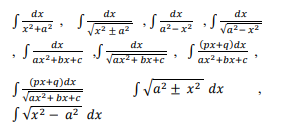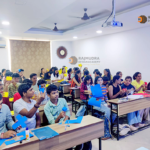Syllabus for Paper-2 (B.Arch) 2022
Part –I MATHEMATICS
UNIT 1: SETS, RELATIONS AND FUNCTIONS:
Sets and their representation: Union,
intersection and complement of sets and their
algebraic properties; Power set; Relation,
Type of relations, equivalence relations,
functions; one-one, into and onto functions,
the composition of functions….
UNIT 2: COMPLEX NUMBERS AND
QUADRATIC EQUATIONS:
Complex numbers as ordered pairs of reals,
Representation of complex numbers in the
form a + ib and their representation in a
plane, Argand diagram, algebra of complex
number, modulus and argument (or
amplitude) of a complex number, triangle
inequality, Quadratic equations in real and
complex number system and their solutions
Relations between roots and co-efficient,
nature of roots, the formation of quadratic
equations with given roots.
UNIT 3: MATRICES AND DETERMINANTS:
Matrices, algebra of matrices, type of
matrices, determinants and matrices of order
two and three, properties of determinants,
evaluation of determinants, area of triangles
using determinants, Adjoint and evaluation
of inverse of a square matrix using
determinants and elementary
transformations, Test of consistency and
solution of simultaneous linear equations in
two or three variables using determinants and
matrices.
UNIT 4: PERMUTATIONS AND
COMBINATIONS:
The fundamental principle of counting,
permutation as an arrangement and
combination as section, Meaning of P (n,r)
and C (n,r), simple applications.
UNIT 5: MATHEMATICAL INDUCTIONS:
Principle of Mathematical Induction and its
simple applications.
UNIT 6: BINOMIAL THEOREM AND ITS
SIMPLE APPLICATIONS:
Binomial theorem for a positive integral
index, general term and middle term,
properties of Binomial coefficients and
simple applications.
UNIT 7: SEQUENCE AND SERIES:
Arithmetic and Geometric progressions,
insertion of arithmetic, geometric means
between two given numbers, Relation
between A.M and G.M sum up to n terms of
special series; Sn, Sn2, Sn3. Arithmetico Geometric progression.
UNIT 8: LIMIT, CONTINUITY AND
DIFFERENTIABILITY:
Real – valued functions, algebra of functions,
polynomials, rational, trigonometric,
logarithmic and exponential functions,
inverse function. Graphs of simple functions.
Limits, continuity and differentiability.
Differentiation of the sum, difference,
product and quotient of two functions.
Differentiation of trigonometric, inverse
trigonometric, logarithmic, exponential,
composite and implicit functions; derivatives
of order up to two, Rolle’s and Lagrange’s
Mean value Theorems, Applications of
derivatives: Rate of change of quantities,
monotonic-Increasing and decreasing
functions, Maxima and minima of functions
of one variable, tangents and normal.
UNIT 9: INTEGRAL CALCULAS:
Integral as an anti-derivative, Fundamental
Integrals involving algebraic, trigonometric,
exponential and logarithms functions.
Integrations by substitution, by parts and by
partial functions. Integration using
trigonometric identities.
Evaluation of simple integrals of the type

Integral as limit of a sum. The fundamental
theorem of calculus, properties of definite
integrals. Evaluation of definite integrals,
determining areas of the regions bounded by
simple curves in standard form.
UNIT 10: DIFFRENTIAL EQUATIONS
Ordinary differential equations, their order
and degree, the formation of differential
equations, solution of differential equation by
the method of separation of variables,
solution of a homogeneous and linear
differential equation of the type

UNIT 11: CO-ORDINATE GEOMETRY
Cartesian system of rectangular co-ordinates
10 in a plane, distance formula, sections
formula, locus and its equation, translation of
axis, slop of a line, parallel and perpendicular
lines, intercept of a line on the co-ordinate
axes
Straight line
Various forms of equations of a line,
intersection of lines, angles between two
lines, conditions for concurrence of three
lines, the distance of a point form a line,
equations of internal and external by sectors
of angles between two lines co-ordinate of
the centroid, orthocentre and circumcentre of
a triangle, equation of the family of lines
passing through the point of intersection of
two lines.
Circle, conic sections
A standard form of equations of a circle, the
general form of the equation of a circle, its
radius and central, equation of a circle when
the endpoints of a diameter are given, points
of intersection of a line and a circle with the
centre at the origin and condition for a line to
be tangent to a circle, equation of the tangent,
sections of conics, equations of conic
sections (parabola, ellipse and hyperbola) in
standard forms, condition for Y = mx + c to
be a tangent and point (s) of tangency.
UNIT 12: THREE DIMENSIONAL
GEOMETRY
Coordinates of a point in space, the distance
between two points, section formula,
directions ratios and direction cosines, the
angle between two intersecting lines. Skew
lines, the shortest distance between them and
its equation. Equations of a line and a plane
in different forms, the intersection of a line
and a plane, coplanar lines.
UNIT 13: VECTOR ALGEBRA
Vectors and scalars, the addition of vectors,
components of a vector in two dimensions
and three-dimensional space, scalar and
vector products, scalar and vector triple
product.
UNIT 14: STATISTICS AND PROBABILITY
Measures of discretion; calculation of mean,
median, mode of grouped and ungrouped
data calculation of standard deviation,
variance and mean deviation for grouped and
ungrouped data.
Probability: Probability of an event, addition
and multiplication theorems of probability,
Baye’s theorem, probability distribution of a
random variate, Bernoulli trials and binomial
distribution.
UNIT 15: TRIGONOMETRY
Trigonometrical identities and equations,
trigonometrical functions, inverse
trigonometrical functions and their
properties, heights and distance.
UNIT 16: MATHEMATICAL REASONING
Statement logical operations and, or, implies,
implied by, if and only if, understanding of
tautology, contradiction, converse, and
contrapositive.
Part –II APTITUDE
UNIT – 1 Awareness of persons. Buildings,
Materials.
Objects, Texture related to Architecture
and Build-envirounment Visusalising three-dimensional objects from two-dimensional
drawings. Visualizing. Different sides of
three-dimensional objects. Analytical
Reasoning Mental Ability (Visual.
Numerical and Verbal)
UNIT – 2 Three dimensional- perception:
Three dimensional- perception:
Understanding and appreciation of scale and
proportions of objects, building forms and
elements, colour texture harmony and
contrast Design and drawing of geometrical
or abstract shapes and patterns in pencil.
Transformation of forms both 2D and 3D
union, subtraction rotation, development of
surfaces and volumes, Generation of plans,
elevations, and 3D views of objects, Creating
two-dimensional and three-dimensional
compositions using given shapes and forms.
Part – III DRAWING
Sketching of scenes and activities from
memory of urbanscape (public space,
market, festivals, street scenes, monuments,
recreational spaces, etc). landscape
(riverfronts. Jungle. Gardens, trees. Plants,
etc.) and rural life.
Note: Candidates are advised to bring
pencils. Own geometry box set, crasets and
colour pencils and crayons for the Drawing
Test.




